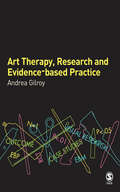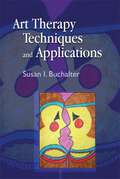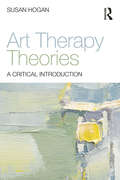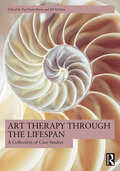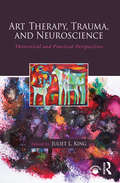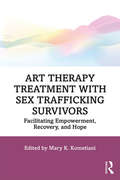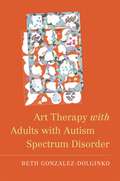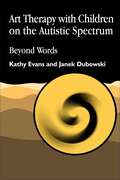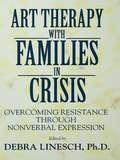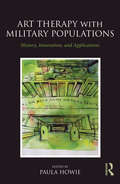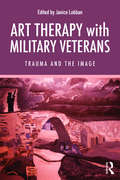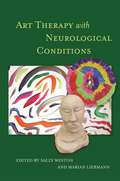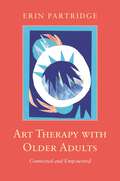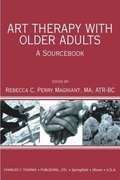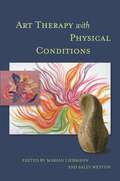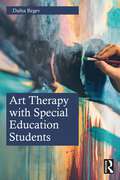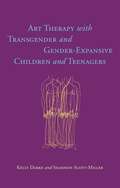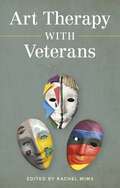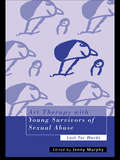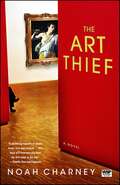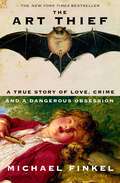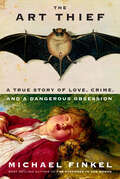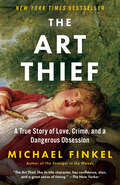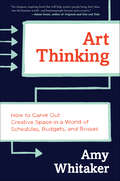- Table View
- List View
Art Therapy, Research and Evidence-based Practice
by Dr Andrea Gilroy`This is an important and topical book coming at a time when there is growing pressure to show evidence of good practice, in order to reassure the prospective client, and to demonstrate financial accountability. It gives valuable guidelines and examples for art therapists. The book is innovative and inspiring, and the author's enthusiasm shines through. I end with the last line of this topical, readable, relevant book - one that encapsulates its content: 'We need the facts, we need the figures, but we need the stories and the pictures, too' - Therapy Today `This book makes a major contribution to the field of art therapy by reviewing, in an accessible and informed manner, the issues around the development of research-informed practice. The author offers an overview of different traditions of inquiry that will be of value to practitioners as well as those actually involved in carrying out research' - John McLeod, Tayside Institute for Health Studies, University of Abertay Dundee `This impressive book is lively, inspiring and innovative. Andrea Gilroy's energetic enthusiasm for her subject is infectious. She breathes life into the topics of research and EBP. This rich exploration combines a rigorous investigation of the existing literature with intelligent, original and practical suggestions. A thorough, informative approach that challenges existing thinking. This is a must for art therapists - at last a book that places art at the centre of our evidence in a convincingly argued, accessible and rewarding read' - Professor Joy Schaverien PhD Art Therapy around the world is under increasing pressure to become more "evidence-based". As a result, practitioners now need to get to grips with what constitutes "evidence", how to apply research in appropriate ways and also how to contribute to the body of evidence through their own research and other related activities. Written specifically for art therapy practitioners and students, Art Therapy, Research & Evidence Based Practice: " traces the background to EBP " critically reviews the existing art therapy research " explains the research process " links research with the development of clinical guidelines, and " describes the knowledge and skills needed to demonstrate efficacy. Drawing on her own experience as a researcher, practitioner and lecturer, Andrea Gilroy looks at the implications of EBP for art therapy and examines common concerns about the threat it may pose to the future provision of art therapy within public services. Art Therapy, Research Evidence-Based Practice addresses issues which are critical to the future development and even the survival of art therapy. Combining insightful analysis with practical guidance and examples, this is an ideal resource for practitioners and for those in training. Andrea Gilroy is Reader in Art Psychotherapy at Goldsmiths, University of London.
Art Therapy Techniques and Applications
by Susan Buchalter Tracylynn NavarroArt Therapy Techniques and Applications contains an original composite of therapeutic goals and evocative ideas that can be used with a wide variety of clients. This book is filled with innovative suggestions and plans that are easily implemented: from brief warm-ups to stretch the imagination, and collage and mask creations to assist the expression of mood, to guidance on combining modalities such as art, metaphors and movement, mindfulness exercises, and using computer programs to enhance art therapy projects. Clear and concise, this is an indispensable reference guide for the therapist who wants to improve focus, develop problem-solving skills, and add creativity to their group work. This book will appeal to art therapists, art therapy students and professors, counselors, and social workers.
Art Therapy Theories: A Critical Introduction
by Susan HoganArt therapists work with a range of distinct philosophical and theoretical underpinnings, but as yet there has been no single book to offer an overview of these theories. Art Therapy Theories provides an introductory, non-partisan overview of art therapy theories outlining the following therapy approaches: Cognitive Behavioural Art Therapy Solution-Focused Brief Therapy Psychoanalytical (Freudian) Art Therapy Analytical (Jungian) Art Therapy Gestalt Art Therapy Person-Centred or 'Rogerian' Art Therapy Mindfulness Art Therapy Integrative Art Therapy (the Group-Interactive Model) Feminist Art Therapy Art Therapy as Social Action Art Therapy as a Research Tool Each chapter provides a non-judgemental, yet analytical, synopsis of each approach. No detailed knowledge is necessary to understand the different approaches, as the book explains them in clear and concise English. Difficult terms and concepts are explained as they arise, and a glossary of terms is also provided. Art Therapy Theories is aimed at trainee art therapists who need to demonstrate that they have a grasp of theory, as well as a sense of how the theory can translate into practice. It will also appeal to seasoned therapists, counsellors and to a wide range of professionals in the mental health field.
Art Therapy Through the Lifespan: A Collection of Case Studies
by Peg Dunn-Snow and Jill McNuttArt Therapy Through the Lifespan: A Collection of Case Studies introduces theories and models of human development highlighted by case studies written by art therapists and broken down by developmental age ranges.Each chapter introduces vignettes written by seasoned art therapists, illuminating the clinical practice of art therapy across relevant developmental levels. Chapters cover major developmental factors through a range of theoretical perspectives, including the definition and use of art therapy, and how developmental knowledge and understanding impact art therapy practice with clients of all ages. The reader will develop an understanding of the impact of human development on assessment, treatment planning, and implementation of art therapy, and will be able to create effective art therapy interventions that coincide with factors related to events across the human lifespan that include normal and abnormal development.The first of its kind, this book encourages and supports readers to develop their knowledge of art therapy and human development across the lifespan with a focus on safety, material quality, and artistic intent.
Art Therapy, Trauma, and Neuroscience: Theoretical and Practical Perspectives (Routledge Mental Health Classic Editions)
by Juliet L. KingArt Therapy, Trauma, and Neuroscience combines theory, research, and practice with traumatized populations in a neuroscience framework. The classic edition includes a new preface from the author discussing advances in the field. Recognizing the importance of a neuroscience- and trauma-informed approach to art therapy practice, research, and education, some of the most renowned figures in art therapy and trauma use translational and integrative neuroscience to provide theoretical and applied techniques for use in clinical practice. Graduate students, therapists, and educators will come away from this book with a refined understanding of brain-based interventions in a dynamic yet accessible format.
Art Therapy, Trauma, and Neuroscience: Theoretical and Practical Perspectives (Routledge Mental Health Classic Editions Ser.)
by Juliet L. KingArt Therapy, Trauma, and Neuroscience combines theory, research, and practice with traumatized populations in a neuroscience framework. Recognizing the importance of understanding both art therapy and trauma studies as brain-based interventions, some of the most renowned figures in art therapy and trauma use translational and integrative neuroscience to provide theoretical and applied techniques. Therapists will come away from this book with tools for a refined understanding of brain-based interventions in a dynamic yet accessible format.
Art Therapy Treatment with Sex Trafficking Survivors: Facilitating Empowerment, Recovery, and Hope
by Mary K. KometianiThis groundbreaking book introduces and researches art therapy as a creative and effective treatment for the sensitive and pertinent issue of human sex trafficking. Rich empirical examples and best practices are provided through the contributors’ expertise and knowledge in the field of art therapy. Art therapy facilitates emotional catharsis, a personal sense of worth and empowerment through making choices; supports connection to others and the inner self; resolves trauma, grief, and shame; and provides hope for the future and recovery. This book explores art therapy interventions and outcomes through detailed case studies for sex trafficking survivors in the United States, India, and Nepal, and includes international recommendations for survivor treatment and recovery, as well as staff support programming. Professional helpers and learners from mental health, social services, medical care, and those who work with trafficking and sexual abuse survivors will benefit from this guide.
Art Therapy with Adults with Autism Spectrum Disorder
by Beth Gonzalez-DolginkoThere is a distinct lack of art therapy literature on working with adults with autism spectrum disorders, and this book combats this dearth by looking at the theory and practice of working with this client group. With clinical case examples throughout, it provides ideas for practice and interventions for use in institutional and community settings. There is a useful focus on directives to help with specific concerns, for example college and job readiness, social skills, and adapting to independent living.The book also includes information on ASD itself and gives advice on developmental and neurological considerations to take into account when working with this client group.
Art Therapy with Children on the Autistic Spectrum: Beyond Words
by Kathy Evans Janek DubowskiRecent research has shown that art therapy can be particularly effective for children with autism and related communication disorders. The extensive range of symptoms experienced by autistic people makes them extremely individual in presentation, so any treatment used must be tailored to a range of varying needs. Art Therapy with Children on the Autistic Spectrum presents a new model of practice, which primarily focuses on communication difficulties. The authors describe how negative behaviours and subsequent tension may be alleviated when the autistic child is involved in interactive art making with the therapist. The book is divided into three parts: the first part explores art making processes and art work, with an emphasis on how art can be specifically communicative. A history of autism is presented within the therapeutic context. The second part challenges existing methods of practice within art therapy and considers the most appropriate approaches to treating autistic children. The last part discusses research that lead to the formulation of this specific model - methodology and assessment interventions are analysed, as well as the ongoing development of appropriate assessment instruments. Case studies of art therapy with individual autistic children demonstrate the use of the model and the outcomes. Throughout the book, it is emphasised how art therapy works as an integral part of overall management and treatment approaches to autism. It will be of particular interest to all those professionals working with autistic children and specialists in other communication disorders.
Art Therapy With Families In Crisis: Overcoming Resistance Through Nonverbal Expression
by Debra LineschThis volume describes art therapy interventions for particularly dysfunctional families and explains the connections between the process of creating art and the curative process in meeting these families' needs. The first chapter examines distressed family systems, and psychotherapy in relation to the uses of art therapy. Subsequent chapters present a crisis intervention model for family art therapy and demonstrate the applications of this model with single-parent families, families affcetd by alcoholism or sexual abuse, and families of political refugees and disaster victims. More than 70 samples of the art produced by these families are reproduced and analyzed.
Art Therapy with Military Populations: History, Innovation, and Applications
by Paula HowieFor decades, art therapy has proved to be a practical treatment for veterans and other military populations suffering from trauma. Art Therapy with Military Populations provides an in-depth overview of both the theoretical and historical bases of art therapy with these groups while also chronicling the latest trends in treatment and the continued expansion of treatment settings. Edited by an art therapist with over 25 years’ experience working with the military and including chapters by a variety of seasoned and innovative clinicians, this comprehensive new volume provides professionals with cutting edge knowledge and interventions for working with military service members and their families. Available for download are employment resources for art therapists who would like to work in military settings, a bonus chapter, historical documents on establishing art therapy, a treatment objectives manual, and resources for art therapists.
Art Therapy with Military Veterans: Trauma and the Image
by Janice LobbanArt Therapy with Military Veterans: Trauma and the Image provides a comprehensive framework for understanding and applying art therapy with former and serving armed forces personnel who have Post-Traumatic Stress Disorder (PTSD). This book brings together experienced contributors in one volume to provide the range of information essential to those seeking to understand the complexities of working in this context. In recent years, art therapy has received increasing attention as a promising treatment for veterans with PTSD. This cutting-edge book provides vital background information on PTSD, military culture and mental health provision, and an effective art therapy working model. The text explores creative partnerships with other disciplines, in different settings, and includes first-hand accounts from veterans about the role art therapy has played in their recovery. This accessible book is a timely response to growing recognition of the value of art therapy with veterans, and it also addresses issues relevant to the wider population of people whose lives have been detrimentally affected by trauma. With chapters authored by leading clinicians in this field, Art Therapy with Military Veterans: Trauma and the Image will be of interest to all art therapists and mental health professionals working with traumatised veterans.
Art Therapy with Neurological Conditions
by Jackie Ashley Quentin Bruckland Elizabeth Ashby Anna Knight Christopher Day Judith Ducker Iris Von Hyde Marian Liebmann Mark Wheeler Sally Weston Marion Green Debbie Michaels Melody Golebiowski Andrea Gregg Simon Bell Carole Connelly Jenny WoodBy creating a therapeutic outlet for self-expression and processing trauma, art therapy can play a powerful role in assisting people with a brain injury or neurological condition to adjust to living with altered abilities and ways of thinking. Bringing together a wealth of expertise from specialists working with a range of conditions including epilepsy, dementia, acquired brain injury, motor neurone disease and multiple sclerosis, this book describes both the effects of the conditions and the ways in which art therapy has helped in the rehabilitation process. The book includes work with groups and individuals and with a wide range of settings and age groups, from children to older adults, and discusses the implications of research from neuroscience and neuropsychology. This will be essential reading for art therapists and students working with neurological conditions. Other professionals working with people with neurological conditions such as psychotherapists and counsellors, doctors, nurses and complementary therapists will also find it of interest.
Art Therapy with Older Adults: Connected and Empowered
by Erin PartridgeThis book outlines a framework for art therapy with older adults rooted in a belief in the autonomy and self-efficacy of older adults, including those with dementia or other diseases of later life.Advocating for a more collaborative approach to art-making, the author presents approaches and directives designed to facilitate community engagement, stimulate intellectual and emotional exploration, and promote a sense of individual and collective empowerment. Relevant to community, assisted living, skilled nursing and dementia-care environments, it includes detailed case studies and ideas for using art therapy to tackle stigma around stroke symptoms and dementia, encourage increased interactions between older adults in care homes, promote resilience, and much more.
Art Therapy with Older Adults: A Sourcebook
by Rebecca C. Perry MagniantDivided into three sections, this book proposes creative art therapies interventions, directives, and ideas along with model programs and examples of work in different settings. Section I discusses art therapy interventions and ideas for treatment, including working with ceramics, sandtray, memory books, and directives. Section II deals with working with specific populations of older adults, caregivers of older adults, and older adults in long-term care and residential settings. In addition, working with older adults with Alzheimer's disease is addressed in this section. Section III focuses on working with individual older adult clients, home-based art therapy, grandmothers raising troubled teenagers, hospice patients, and mentally ill geriatrics.
Art Therapy with Physical Conditions
by Michael Fischer Karen Huckvale Michele Wood Dr Trevor Thompson Julie Jackson Malcolm Learmonth Jo Bissonnet Jo Beedell Sarah Lewis Carole Simpson Cherry Lawrence Marian Liebmann Nicki Power Sally Weston Don Ratcliffe Simon Richardson Alison Hawtin Kayleigh Orr Jo CliftonAs the emotional components of physical illnesses become more recognised, there is a renewed interest in the potential of art therapy to help patients come to terms with injury, pain and terminal and life-long conditions. A wide range of experienced art therapists describe their work and its benefits to a variety of groups including those with cancer, debilitating conditions such as myalgic encephalopathy (M.E.) and ulcerative colitis. Physical conditions in combination with other factors such as homelessness or learning disabilities, and children with life-long and chronic conditions are also covered. The book includes discussion of spiritual and philosophical issues when mortality is faced, life change and adjustment issues, practical considerations and which models of practice art therapists find most helpful with various groups. This will be essential reading for arts therapists and students, as well as for professionals with an interest in psychological issues and wellbeing for patients with physical illness or long term conditions, such as psychotherapists and counsellors, complementary therapists, doctors, nurses and other healthcare professionals.
Art Therapy with Special Education Students
by Dafna RegevArt Therapy with Special Education Students is a practical and innovative book that details the best suitable ways to work in the field of art therapy with special education students. This book provides the reader with practical approaches, techniques, models, and methodologies in art therapy that focus on special education students, such as those with ASD, ADHD, learning disabilities, behavioral disorders, and students with visual and hearing impairments. Each chapter addresses a specific population, including an overview of the literature in the field, along with descriptions of practices derived from interviews with experienced art therapists who specialize in each population. The chapters cover the therapeutic goals of each population, the specific challenges, intervention techniques, and the meaning of art. Dedicated working models that have emerged in the field and collaborative interventions involving parents and staff members, along with clinical illustrations, are also available throughout the book. Art therapists and mental health professionals in the school system will appreciate this comprehensive collection of contemporary work in the field of art therapy with special education students.
Art Therapy with Transgender and Gender-Expansive Children and Teenagers
by Kelly Darke Shannon Scott-MillerAn educational and inspirational book that offers practical guidance for art therapists working with transgender and gender-expansive youth and their families. It provides art therapy goals, recommended treatments and coping skills to use with this client group.Each chapter looks at how art therapy can address a different concern or aspect of the experience, such as transitioning, bullying, and recognizing or building a support system. It includes detailed case studies and cutting-edge art therapy interventions, which help young people to express the emotions surrounding the discovery of gender identity, the transition process, and self-care.
Art Therapy with Veterans
by Jashley Boatwright Kevin D’Augustine Deborah Murphy Courtney Bennett Gioia Chilton Raquel Farrell-Kirk Peter Buotte Meredith McMackin Erin PartridgeWith both personal and professional insight from a range of contributors, this informative guide highlights the use of art therapy in a range of settings to support military veterans. Offering a wealth of knowledge on this approach and the variety of current programs available, this is an invaluable resource for all therapists looking to provide support for this population.Chapters explore the use of art therapy in a range of different settings, including museum programs, open studio therapy and assisted living environments, as well as large group therapy at treatment facilities for active-duty service members. It also offers rare insight into the effectiveness of art therapy in supporting veterans who are processing military sexual trauma, moral injury and countertransference, filling essential gaps in knowledge within this area.As demand for this practice continues to grow, Art Therapy with Veterans provides inspiration for future programs and therapists looking to support military communities.
Art Therapy with Young Survivors of Sexual Abuse: Lost for Words
by Jenny MurphyDealing with the aftermath of childhood sexual abuse remains one of the major issues in child and adolescent mental health. Yet, until now, little has been written for art therapists and related professionals involved in this sensitive field. Art Therapy with Young Survivors of Sexual Abuse is a guide to practice with this group. Containing a range of illustrative case material from both individual and group therapy, the book addresses the important issues faced by professionals, including:* male therapist countertransference* the therapist's relationship with the client's family and wider networks* assessment using art therapy* the value of art therapy with groups.Art Therapy with Young Survivors of Sexual Abuse will provide not only art therapists, but other professionals working with sexually abused children and adolescents, with a stimulating discussion of the current issues in this area.
The Art Thief: A Novel
by Noah CharneyRome: In the small Baroque church of Santa Giuliana, a magnificent Caravaggio altarpiece disappears without a trace in the middle of the night. Paris: In the basement vault of the Malevich Society, curator Geneviéve Delacloche is shocked to discover the disappearance of the Society's greatest treasure, White-on-White by Suprematist painter Kasimir Malevich. London: At the National Gallery of Modern Art, the museum's latest acquisition is stolen just hours after it was purchased for more than six million pounds. In The Art Thief, three thefts are simultaneously investigated in three cities, but these apparently isolated crimes have much more in common than anyone imagines. In Rome, the police enlist the help of renowned art investigator Gabriel Coffin when tracking down the stolen masterpiece. In Paris, Geneviéve Delacloche is aided by Police Inspector Jean-Jacques Bizot, who finds a trail of bizarre clues and puzzles that leads him ever deeper into a baffling conspiracy. In London, Inspector Harry Wickenden of Scotland Yard oversees the museum's attempts to ransom back its stolen painting, only to have the masterpiece's recovery deepen the mystery even further. A dizzying array of forgeries, overpaintings, and double-crosses unfolds as the story races through auction houses, museums, and private galleries -- and the secret places where priceless works of art are made available to collectors who will stop at nothing to satisfy their hearts' desires. Full of fascinating art-historical detail, crackling dialogue, and a brain-teasing plot, Noah Charney's debut novel is a sophisticated, stylish thriller, as irresistible and multifaceted as a great work of art.
The Art Thief
by Michael FinkelThe true story of the world&’s most prolific art thief, who accumulated a collection worth over $1.4 billion. A spellbinding portrait of obsession and flawed genius, from the bestselling author of The Stranger in the Wood. For centuries, works of art have been stolen in countless ways from all over the world, but no one has been quite as successful at it as the master thief Stéphane Breitwieser. Carrying out more than 200 heists over nearly ten years - in museums and cathedrals all over Europe - Breitwieser, along with his girlfriend who worked as his lookout, stole more than 300 objects, until it all fell apart in spectacular fashion. In The Art Thief, Michael Finkel brings us into Breitwieser&’s strange and fascinating world. Unlike most thieves, he never stole for money, keeping all his treasures in his home, where he could admire them to his heart&’s content. Possessed of a remarkable appreciation for art and an innate ability to assess practically any security system, Breitwieser managed to pull off a breathtakingly number of audacious thefts. Yet these strange talents bred a growing disregard for risk and an addict&’s need to score, leading Breitwieser to ignore his girlfriend&’s pleas to stop - until one final act of hubris brought everything crashing down. This is a riveting story of art, crime, and an insatiable hunger to possess beauty at any cost. As a real page-turner that seems almost unbelievable in its twists and turns, The Art Thief explores the true story of the art collector who went to extreme lengths to expand his personal collection – and the thrill of the heist that kept him going.
The Art Thief: A True Story of Love, Crime, and a Dangerous Obsession
by Michael FinkelOne of the most remarkable true-crime narratives of the twenty-first century: the story of the world&’s most prolific art thief, Stéphane Breitwieser. • &“The Art Thief, like its title character, has confidence, élan, and a great sense of timing."—The New Yorker "Enthralling." —The Wall Street JournalIn this spellbinding portrait of obsession and flawed genius, the best-selling author of The Stranger in the Woods brings us into Breitwieser&’s strange world—unlike most thieves, he never stole for money, keeping all his treasures in a single room where he could admire them.For centuries, works of art have been stolen in countless ways from all over the world, but no one has been quite as successful at it as the master thief Stéphane Breitwieser. Carrying out more than two hundred heists over nearly eight years—in museums and cathedrals all over Europe—Breitwieser, along with his girlfriend who worked as his lookout, stole more than three hundred objects, until it all fell apart in spectacular fashion.In The Art Thief, Michael Finkel brings us into Breitwieser&’s strange and fascinating world. Unlike most thieves, Breitwieser never stole for money. Instead, he displayed all his treasures in a pair of secret rooms where he could admire them to his heart&’s content. Possessed of a remarkable athleticism and an innate ability to circumvent practically any security system, Breitwieser managed to pull off a breathtaking number of audacious thefts. Yet these strange talents bred a growing disregard for risk and an addict&’s need to score, leading Breitwieser to ignore his girlfriend&’s pleas to stop—until one final act of hubris brought everything crashing down.This is a riveting story of art, crime, love, and an insatiable hunger to possess beauty at any cost.
The Art Thief: A True Story of Love, Crime, and a Dangerous Obsession
by Michael FinkelNEW YORK TIMES BEST SELLER • One of the most remarkable true-crime narratives of the twenty-first century: the story of the world&’s most prolific art thief, Stéphane Breitwieser. • &“The Art Thief, like its title character, has confidence, élan, and a great sense of timing."—The New YorkerA BEST BOOK OF THE YEAR: The Washington Post, The New Yorker, Lit Hub "Enthralling." —The Wall Street JournalIn this spellbinding portrait of obsession and flawed genius, the best-selling author of The Stranger in the Woods brings us into Breitwieser&’s strange world—unlike most thieves, he never stole for money, keeping all his treasures in a single room where he could admire them.For centuries, works of art have been stolen in countless ways from all over the world, but no one has been quite as successful at it as the master thief Stéphane Breitwieser. Carrying out more than two hundred heists over nearly eight years—in museums and cathedrals all over Europe—Breitwieser, along with his girlfriend who worked as his lookout, stole more than three hundred objects, until it all fell apart in spectacular fashion.In The Art Thief, Michael Finkel brings us into Breitwieser&’s strange and fascinating world. Unlike most thieves, Breitwieser never stole for money. Instead, he displayed all his treasures in a pair of secret rooms where he could admire them to his heart&’s content. Possessed of a remarkable athleticism and an innate ability to circumvent practically any security system, Breitwieser managed to pull off a breathtaking number of audacious thefts. Yet these strange talents bred a growing disregard for risk and an addict&’s need to score, leading Breitwieser to ignore his girlfriend&’s pleas to stop—until one final act of hubris brought everything crashing down.This is a riveting story of art, crime, love, and an insatiable hunger to possess beauty at any cost.
Art Thinking: How to Carve Out Creative Space in a World of Schedules, Budgets, and Bosses
by Amy WhitakerAn indispensable and inspiring guide to creativity in the workplace and beyond, drawing on art, psychology, science, sports, law, business, and technology to help you land big ideas in the practical world.Anyone from CEO to freelancer knows how hard it is to think big, let alone follow up, while under pressure to get things done. Art Thinking offers practical principles, inspiration, and a healthy dose of pragmatism to help you navigate the difficulties of balancing creative thinking with driving toward results.With an MBA and an MFA, Amy Whitaker, an entrepreneur-in-residence at the New Museum Incubator, draws on stories of athletes, managers, writers, scientists, entrepreneurs, and even artists to engage you in the process of “art thinking.” If you are making a work of art in any field, you aren’t going from point A to point B. You are inventing point B.Art Thinking combines the mind-sets of art and the tools of business to protect space for open-ended exploration and manage risks on your way to success. Art Thinking takes you from “Wouldn’t it be cool if . . . ?” to realizing your highest aims, helping you build creative skills you can apply across all facets of business and life. Warm, honest, and unexpected, Art Thinking will help you reimagine your work and life—and even change the world—while enjoying the journey from point A.Art Thinking features 60 line drawings throughout.
